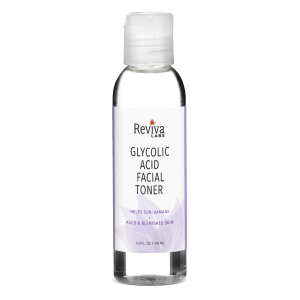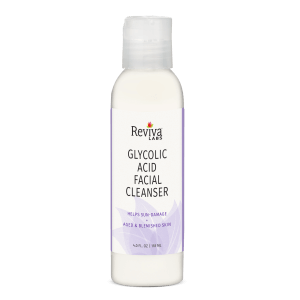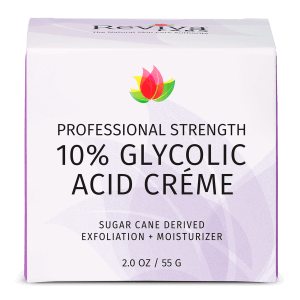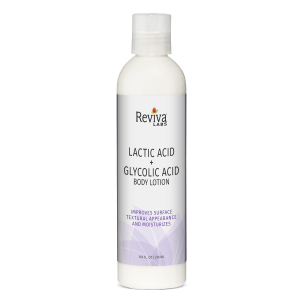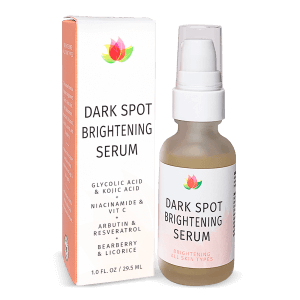Ingredients, Reviva Labs, Skin Care
Does Glycolic Acid Help Remove Dark Spots and Hyperpigmentation?
Dark spots and hyperpigmentation can be a frustrating skin concern that many people struggle with. These stubborn marks seem to linger on our skin, refusing to fade away. Fortunately, there is a skincare ingredient that can effectively address these pigmentation issues and give us the even-toned, radiant skin we desire. That ingredient is glycolic acid.
What Causes Dark Spots and Hyperpigmentation?
Before we dive into how glycolic acid can help fade dark spots, let’s understand the underlying causes of hyperpigmentation. Dark patches and uneven skin tone can be a result of various factors, including:
- Age
- Sun Damage
- Post-Acne Marks
- Pollution Exposure
- Pregnancy
- Ingrown Hairs
- Skin Irritation
These factors contribute to the overproduction of melanin, the pigment responsible for determining our skin color. When melanin is produced in excess in certain areas, it leads to the formation of dark spots on the skin.
The Effectiveness of Glycolic Acid in Fading Dark Spots
Glycolic acid has emerged as a powerful skincare ingredient for reducing the appearance of dark spots and hyperpigmentation. Numerous studies have demonstrated its efficacy in addressing these concerns. But how exactly does glycolic acid work its magic?
Understanding Melanin and Its Role
To comprehend the impact of glycolic acid on dark spots, we need to understand melanin. Melanin is the pigment that gives our skin its color. Individuals with more melanin have darker skin tones, while those with less melanin have lighter skin tones. Sun exposure can trigger the production of additional melanin, resulting in a tan.
However, in some cases, excess melanin is produced in specific areas, leading to the formation of dark spots on the skin.
Glycolic Acid’s Effect on Melanin Production
Glycolic acid plays a crucial role in interrupting the process of melanin production, especially in areas where excessive melanin is being produced. Through regular use, glycolic acid gradually reduces hyperpigmentation and melasma, resulting in a more even skin tone. Moreover, it provides the added benefit of imparting a healthy, radiant glow to the skin.
The Benefits of Glycolic Acid for Dark Spots and Hyperpigmentation
Glycolic acid is undoubtedly one of the best skincare ingredients available for treating dark spots caused by breakouts, hormonal changes, or the natural aging process. Here are some of the key benefits it offers:
1. Exfoliation and Cell Turnover
One of the primary mechanisms through which glycolic acid addresses hyperpigmentation is by exfoliating the skin and promoting cell turnover. Glycolic acid has small molecules that penetrate deep into the skin, dissolving the connections between dead skin cells. As a result, these cells shed more quickly, revealing healthier, less pigmented cells underneath. This process helps restore an even-toned complexion and reduces the appearance of dark spots.
2. Increased Collagen Production
Collagen is a vital protein that provides structure and elasticity to the skin. As we age, collagen production decreases, leading to the formation of fine lines and wrinkles. Glycolic acid has been found to stimulate collagen production, thereby improving skin firmness and reducing the visibility of lines and wrinkles. By incorporating glycolic acid into your skincare routine, you can promote a more youthful appearance.
3. Hydration and Moisture Retention
Glycolic acid acts as a humectant, attracting and binding water to the skin cells. It enhances the synthesis of glycosaminoglycans, which are molecules responsible for drawing water into the skin. By increasing skin hydration, glycolic acid helps maintain moisture balance and prevents dryness, which can exacerbate the appearance of dark spots.
4. Anti-Aging Properties
In addition to its collagen-stimulating effects, glycolic acid also helps combat other signs of aging. It can reduce sun damage, improve skin texture, and enhance the quality of elastin, another protein that contributes to skin elasticity. By addressing multiple aspects of the aging process, glycolic acid offers comprehensive anti-aging benefits.
5. Treatment for Acne and Post-Acne Marks
Glycolic acid’s exfoliating properties make it an effective treatment for acne and post-acne marks. By removing dead skin cells and unclogging pores, it helps prevent breakouts and fade the marks left behind by acne. Regular use of glycolic acid can lead to a clearer, more even complexion.
Choosing the Right Glycolic Acid Product
When selecting a glycolic acid product, it is essential to consider a few factors to ensure optimal results and minimize the risk of skin irritation. Here are some tips for choosing the right glycolic acid product:
1. Concentration and pH Level
Glycolic acid products typically come in varying concentrations. If you are new to using glycolic acid, it is recommended to start with a lower concentration (around 8%) and gradually increase as your skin adjusts. Additionally, consider the pH level of the product. Most over-the-counter glycolic acid products have a pH of around 4, which closely matches the skin’s natural pH.
2. Product Format
Glycolic acid is available in various formats, including cleansers, toners, serums, moisturizers, and masks. For maximum effectiveness, opt for leave-on products that allow the acid to work on the skin over an extended period. This gives the glycolic acid more time to exfoliate and promote cell turnover.
3. Patch Test and Sensitivity
Before incorporating glycolic acid into your skincare routine, perform a patch test on a small area of skin to check for any adverse reactions. This is especially important if you have sensitive skin. If no irritation occurs, you can gradually introduce glycolic acid into your routine, starting with less frequent use and increasing as tolerated.
4. Sun Protection
Glycolic acid can make your skin more sensitive to the sun. It is crucial to apply sunscreen with a high SPF every morning as the last step in your skincare routine. This will protect your skin from harmful UV rays and prevent further darkening of hyperpigmentation.
How to Incorporate Glycolic Acid into Your Skincare Routine
To effectively incorporate glycolic acid into your skincare routine, follow these steps:
- Cleanse your face thoroughly with a gentle cleanser.
- Apply a glycolic acid product in the evening, as it is best to use it during the skin’s rest and repair phase.
- Start with a small amount and gradually increase the frequency of use as your skin tolerates it.
- If you experience any dryness or sensitivity, reduce the frequency of application or use a lightweight moisturizer before applying the glycolic acid product.
- Always follow up with a broad-spectrum sunscreen with SPF 30 or higher before stepping outside.
Remember, consistency is key when using glycolic acid. Regular use over time will yield the best results and help fade dark spots and hyperpigmentation effectively.
Potential Risks and Precautions
While glycolic acid is generally safe to use, it is essential to be aware of potential risks and take necessary precautions:
- Avoid using glycolic acid on broken or sunburned skin.
- If you experience any significant redness, itching, swelling, or burning, discontinue use and consult a healthcare professional.
- Always follow the instructions provided with the product and avoid using higher concentrations or using it more frequently than recommended.
- If you have a known skin condition or are under the care of a dermatologist, consult with them before incorporating glycolic acid into your routine.
This AHA is A-O.K.!
Glycolic acid is a powerful skincare ingredient that can effectively fade dark spots and hyperpigmentation. Its exfoliating properties, collagen-stimulating effects, and ability to improve skin hydration make it a versatile solution for achieving a more even-toned and radiant complexion. By selecting the right glycolic acid product and incorporating it into your skincare routine with caution, you can harness the power of this ingredient to enhance your skin’s appearance and regain your confidence. Remember to prioritize sun protection and consult a healthcare professional if you have any concerns or pre-existing skin conditions. Embrace the journey to healthier, more luminous skin with glycolic acid as your ally.
Quick Summary Video








